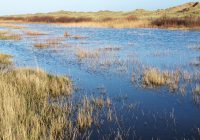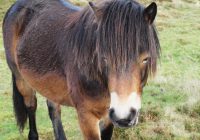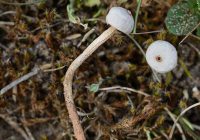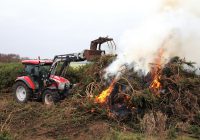Dr Phil Smith’s Wildlife Notes
January 2016
It has been officially reported that 2015 was the warmest year worldwide since records began in 1850. This trend seems set to continue, apart from a brief cold spell in mid-month, January 2016 was also exceptionally mild. A series of Atlantic depressions, including named storms, produced a good deal of wind and rain. My ongoing measurements of the water-table at Devil’s Hole, Ravenmeols, showed a consistent increase throughout the month, reaching a water depth of 48cm on the last day. This means that the water-table has risen 96cm (nearly 3 feet) since the end of October!
Slacks throughout the dune system responded, the New and Newest Green Beaches, north of Ainsdale-on-Sea, being extensively flooded when I visited to take photographs on 22nd, a rare sunny day. At last, the borrow-pits at Cabin Hill National Nature Reserve had enough water to attract snipe, my visit on 9th finding 21 Common Snipe and 10 of the much scarcer and smaller Jack Snipe. This was one of the largest counts I have made here of the latter species, a beautifully-marked, well-camouflaged wader, always reluctant to fly and therefore difficult to find. I also spotted a Short-eared Owl over the adjacent Altcar Rifle Range, while 58 Herdwick sheep and five Shetland Cattle were munching their way through the coarse vegetation built up on the reserve during the previous growing season.
Already by 2nd, the ponds on the Wildlife Trust’s Freshfield Dune Heath Nature Reserve were brim-full, having been bone dry most of the year. Several Robins were singing and Gorse was in good flower. Temporary visitors were four smart Exmoor ponies, grazing a tussocky acid-grassland compartment. Over the last ten years, conservation grazing has greatly improved the condition of this field, which now supports patchy Heather. At the end of the month I visited the heath again to photograph machines removing large patches of Gorse that have become invasive, threatening the diversity of flora and fauna. Nearby, a Chiffchaff was calling persistently. Overwintering by these normally summer visiting warblers has increased in Lancashire and North Merseyside since the 1950s, the Sefton Coast being a particular hotspot. An exceptional 40 Chiffchaffs were reported wintering in 2001. It is thought that most of these birds originate on the continent, though there are few ringing returns to support this theory.
One of my trips to the Devil’s Hole was enriched by the discovery of a large hairy Fox Moth caterpillar. This species hibernates as an adult caterpillar, its appearance no doubt reflecting the unseasonal temperatures. The same area also produced a large number of small stalked puffballs, later identified as Tulostoma brumale (Winter Stalk-ball), a local species appearing in winter on calcareous dunes.
Scrub control on the dunes is a constant refrain during the winter, Natural England’s Dave Mercer telling me of work to eliminate the alien Japanese Rose at Cabin Hill. This is a trial to see which methods are best, some bushes being excavated by machine and buried under 2m of sand, others dug up by hand and a third sample treated with an approved herbicide in the summer. I also organised further “Buckthorn Bashes” in the Birkdale frontal dunes to finish off work begun in October. Groups up to six local volunteers cleared Sea Buckthorn in two more slacks (nos. 44 and 45) and the associated dune ridges, some of which are known to support Sand Lizards. Most of this area had been cut the previous year and it was reassuring to see that the new growth was much smaller than previously. Several unexpected winter flowers included Kidney-vetch, the first time I have ever seen this species flowering in January. Returning from one of the “bashes” we were amazed to find a dead Red-eared Terrapin washed up on the tide-line at Ainsdale. This had presumably been washed out of Sands Lake, rather than being a trans-Atlantic voyager.
Few rare birds were reported locally during the month, an exception being the male American Wigeon which turned up at the RSPB’s Hesketh Out Marsh Nature Reserve for at least a couple of days mid-month. This former great rarity is now seen almost annually in the Northwest, perhaps due to the larger numbers of bird-watchers helped by much improved optical equipment.




